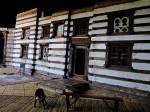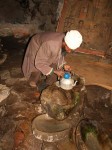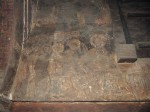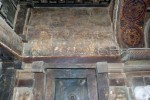 The church of Yemrehanna Kristos in northern Ethiopia was commissioned by and named after a priest-king of the Zagwe dynasty who ruled from about 1087 to 1127. The church was built in the early 12th century in the late Azumite style inside a cave facing northeast on the side of Mount Abuna Yosef in the Lasta Mountains, the church is as beautifully situated as it is remote. The town of Lalibela, later capital of the Zagwe kings of Ethiopia and famous for its rock-hewn churches, is just 12 miles away, but until 15 years ago, Yemrehanna Kristos took a day’s hard ride on a mule to reach. Recently a dirt road was built from Lalibela making the church accessible to 4WD vehicles. Even with a proper Jeep it still takes an hour and a half to get there.
The church of Yemrehanna Kristos in northern Ethiopia was commissioned by and named after a priest-king of the Zagwe dynasty who ruled from about 1087 to 1127. The church was built in the early 12th century in the late Azumite style inside a cave facing northeast on the side of Mount Abuna Yosef in the Lasta Mountains, the church is as beautifully situated as it is remote. The town of Lalibela, later capital of the Zagwe kings of Ethiopia and famous for its rock-hewn churches, is just 12 miles away, but until 15 years ago, Yemrehanna Kristos took a day’s hard ride on a mule to reach. Recently a dirt road was built from Lalibela making the church accessible to 4WD vehicles. Even with a proper Jeep it still takes an hour and a half to get there.
Yemrehanna Kristos was a major site of pilgrimage, especially for people on the verge of death. Inside the cave behind the church are the bones of an estimated 10,000 people who journeyed from everywhere around Ethiopia and as far as Egypt and Syria to die at the holy site. Monks and priests live in the cave, some in a second building beyond the church, others sleeping on woven cots in the open cave.
 The building itself is one of the best-preserved late Axumite churches in the country. The walls are made of timber beams alternating with white plastered stone which give them a striped look. The windows are covered with intricately carved wooden lattices. The design of the church’s interior is a simple central nave with an aisle on each side, divided by masonry pillars and arches. Every piece of wood on the inside of the church is painted. The ceilings are decorated with polychrome painted geometric designs. Scenes from the Bible are painted on the walls.
The building itself is one of the best-preserved late Axumite churches in the country. The walls are made of timber beams alternating with white plastered stone which give them a striped look. The windows are covered with intricately carved wooden lattices. The design of the church’s interior is a simple central nave with an aisle on each side, divided by masonry pillars and arches. Every piece of wood on the inside of the church is painted. The ceilings are decorated with polychrome painted geometric designs. Scenes from the Bible are painted on the walls.
 These murals are the oldest surviving wall paintings in Ethiopia, but they weren’t even published internationally until 2001 because between the layers of dirt on the surface and the darkness of the interior of the cave, they’re hard to see.
These murals are the oldest surviving wall paintings in Ethiopia, but they weren’t even published internationally until 2001 because between the layers of dirt on the surface and the darkness of the interior of the cave, they’re hard to see.
The figurative images are mainly New Testament scenes, many of which are now barely legible because of an accumulation of dirt. They include a depiction of the arrival in Egypt of the Holy Family, who are welcomed by an angel. Mary rides a donkey, with Joseph walking behind, carrying the Christ Child on his shoulders. The wooden ceiling is decorated
with 17 painted medallions of animal motifs: wild beasts, birds, an elephant, a winged creature, a scorpion and a dragon. Other wall paintings have geometric designs.
The murals and church are in dire need of the tender attentions of conservators. Earthquake tremors have weakened the structure, putting cracks in the walls and damaging the priceless decoration. Previous inexpert and undocumented attempts at restoration have coated the murals with a layer of varnish, now darkened, and a rough cleaning attempt left brush marks on the surface.
 Last fall, the World Monuments Fund (WMF) received a $150,000 grant from the U.S. State Department Ambassadors Fund for Cultural Preservation (AFCP) to fund an 18 month-long structural analysis of the church, interior and exterior. Laser scanning and motion monitors will hopefully pinpoint the source of the movement in the building and identify areas of top concern. The WMF will work with the Ethiopian Heritage Fund (EHF) on the project.
Last fall, the World Monuments Fund (WMF) received a $150,000 grant from the U.S. State Department Ambassadors Fund for Cultural Preservation (AFCP) to fund an 18 month-long structural analysis of the church, interior and exterior. Laser scanning and motion monitors will hopefully pinpoint the source of the movement in the building and identify areas of top concern. The WMF will work with the Ethiopian Heritage Fund (EHF) on the project.
The initial investigation will include in-situ microscopy, along with ultra-violet and infra-red examinations. Paint samples will be tested, partly to determine the original pigments and media used and to identify added materials. There will be small-scale cleaning trials, to test which materials should be used. Monitoring sensors will be installed to record temperature and humidity changes. A separate team from the University of Cape Town will undertake a laser scan survey to create a three-dimensional data model of the church and cave, to map structural movement.
Once they have the data, they will conserve the paintings for the first time under contemporary professional conditions. If all goes well, conservation will begin by October of this year and continue through early next year. The objectives will be to stop the paint from flaking and to clean the murals thoroughly.